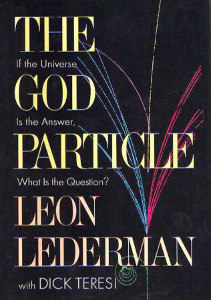
In particle physics, an elementary particle or fundamental particle is a subatomic particle that is not composed of other particles. The Standard Model presently recognizes seventeen distinct particles—twelve fermions and five bosons. As a consequence of flavor and color combinations and antimatter, the fermions and bosons are known to have 48 and 13 variations, respectively. Among the 61 elementary particles embraced by the Standard Model number: electrons and other leptons, quarks, and the fundamental bosons. Subatomic particles such as protons or neutrons, which contain two or more elementary particles, are known as composite particles.

Leon Max Lederman was an American experimental physicist who received the Nobel Prize in Physics in 1988, along with Melvin Schwartz and Jack Steinberger, for research on neutrinos. He also received the Wolf Prize in Physics in 1982, along with Martin Lewis Perl, for research on quarks and leptons. Lederman was director emeritus of Fermi National Accelerator Laboratory (Fermilab) in Batavia, Illinois. He founded the Illinois Mathematics and Science Academy, in Aurora, Illinois in 1986, where he was resident scholar emeritus from 2012 until his death in 2018.

Particle physics or high-energy physics is the study of fundamental particles and forces that constitute matter and radiation. The field also studies combinations of elementary particles up to the scale of protons and neutrons, while the study of combination of protons and neutrons is called nuclear physics.

The Standard Model of particle physics is the theory describing three of the four known fundamental forces in the universe and classifying all known elementary particles. It was developed in stages throughout the latter half of the 20th century, through the work of many scientists worldwide, with the current formulation being finalized in the mid-1970s upon experimental confirmation of the existence of quarks. Since then, proof of the top quark (1995), the tau neutrino (2000), and the Higgs boson (2012) have added further credence to the Standard Model. In addition, the Standard Model has predicted various properties of weak neutral currents and the W and Z bosons with great accuracy.
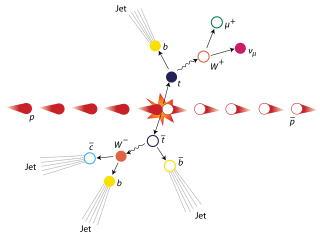
The top quark, sometimes also referred to as the truth quark, is the most massive of all observed elementary particles. It derives its mass from its coupling to the Higgs Boson. This coupling is very close to unity; in the Standard Model of particle physics, it is the largest (strongest) coupling at the scale of the weak interactions and above. The top quark was discovered in 1995 by the CDF and DØ experiments at Fermilab.
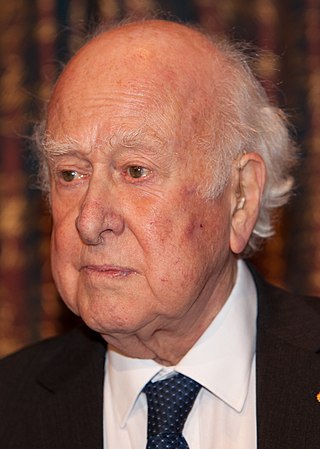
Peter Ware Higgs was a British theoretical physicist, professor at the University of Edinburgh, and Nobel laureate in Physics for his work on the mass of subatomic particles. The largest thing named after a human is the Higgs Field.

The Large Hadron Collider (LHC) is the world's largest and highest-energy particle collider. It was built by the European Organization for Nuclear Research (CERN) between 1998 and 2008 in collaboration with over 10,000 scientists and hundreds of universities and laboratories across more than 100 countries. It lies in a tunnel 27 kilometres (17 mi) in circumference and as deep as 175 metres (574 ft) beneath the France–Switzerland border near Geneva.

The Superconducting Super Collider (SSC) was a particle accelerator complex under construction in the vicinity of Waxahachie, Texas, United States.

In the Standard Model of particle physics, the Higgs mechanism is essential to explain the generation mechanism of the property "mass" for gauge bosons. Without the Higgs mechanism, all bosons (one of the two classes of particles, the other being fermions) would be considered massless, but measurements show that the W+, W−, and Z0 bosons actually have relatively large masses of around 80 GeV/c2. The Higgs field resolves this conundrum. The simplest description of the mechanism adds a quantum field (the Higgs field) which permeates all of space to the Standard Model. Below some extremely high temperature, the field causes spontaneous symmetry breaking during interactions. The breaking of symmetry triggers the Higgs mechanism, causing the bosons it interacts with to have mass. In the Standard Model, the phrase "Higgs mechanism" refers specifically to the generation of masses for the W±, and Z weak gauge bosons through electroweak symmetry breaking. The Large Hadron Collider at CERN announced results consistent with the Higgs particle on 14 March 2013, making it extremely likely that the field, or one like it, exists, and explaining how the Higgs mechanism takes place in nature. The view of the Higgs mechanism as involving spontaneous symmetry breaking of a gauge symmetry is technically incorrect since by Elitzur's theorem gauge symmetries can never be spontaneously broken. Rather, the Fröhlich–Morchio–Strocchi mechanism reformulates the Higgs mechanism in an entirely gauge invariant way, generally leading to the same results.

The DØ experiment was a worldwide collaboration of scientists conducting research on the fundamental nature of matter. DØ was one of two major experiments located at the Tevatron Collider at Fermilab in Batavia, Illinois. The Tevatron was the world's highest-energy accelerator from 1983 until 2009, when its energy was surpassed by the Large Hadron Collider. The DØ experiment stopped taking data in 2011, when the Tevatron shut down, but data analysis is still ongoing. The DØ detector is preserved in Fermilab's DØ Assembly Building as part of a historical exhibit for public tours.

François, Baron Englert is a Belgian theoretical physicist and 2013 Nobel Prize laureate.
The timeline of particle physics lists the sequence of particle physics theories and discoveries in chronological order. The most modern developments follow the scientific development of the discipline of particle physics.
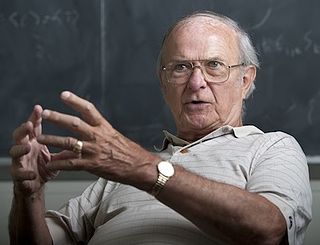
Carl Richard Hagen is a professor of particle physics at the University of Rochester. He is most noted for his contributions to the Standard Model and Symmetry breaking as well as the 1964 co-discovery of the Higgs mechanism and Higgs boson with Gerald Guralnik and Tom Kibble (GHK). As part of Physical Review Letters 50th anniversary celebration, the journal recognized this discovery as one of the milestone papers in PRL history. While widely considered to have authored the most complete of the early papers on the Higgs theory, GHK were controversially not included in the 2013 Nobel Prize in Physics.

Christopher T. Hill is an American theoretical physicist at the Fermi National Accelerator Laboratory who did undergraduate work in physics at M.I.T., and graduate work at Caltech. Hill's Ph.D. thesis, "Higgs Scalars and the Nonleptonic Weak Interactions" (1977) contains one of the first detailed discussions of the two-Higgs-doublet model and its impact upon weak interactions. His work mainly focuses on new physics that can be probed in laboratory experiments or cosmology.
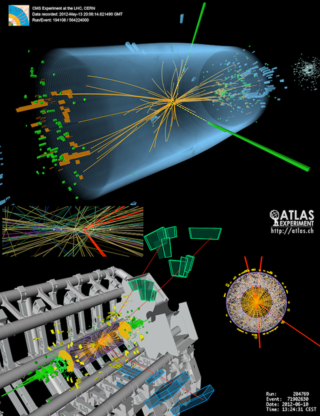
The Higgs boson, sometimes called the Higgs particle, is an elementary particle in the Standard Model of particle physics produced by the quantum excitation of the Higgs field, one of the fields in particle physics theory. In the Standard Model, the Higgs particle is a massive scalar boson with zero spin, even (positive) parity, no electric charge, and no colour charge that couples to mass. It is also very unstable, decaying into other particles almost immediately upon generation.
The 1964 PRL symmetry breaking papers were written by three teams who proposed related but different approaches to explain how mass could arise in local gauge theories. These three papers were written by: Robert Brout and François Englert; Peter Higgs; and Gerald Guralnik, C. Richard Hagen, and Tom Kibble (GHK). They are credited with the theory of the Higgs mechanism and the prediction of the Higgs field and Higgs boson. Together, these provide a theoretical means by which Goldstone's theorem can be avoided. They showed how gauge bosons can acquire non-zero masses as a result of spontaneous symmetry breaking within gauge invariant models of the universe.
Particle accelerators in popular culture appear in popular science books, fictional literature, feature films, TV series and other media which include particle accelerators as part of their content. Particle physics, fictional or scientific, is an inherent part of this topic.

The idea that matter consists of smaller particles and that there exists a limited number of sorts of primary, smallest particles in nature has existed in natural philosophy at least since the 6th century BC. Such ideas gained physical credibility beginning in the 19th century, but the concept of "elementary particle" underwent some changes in its meaning: notably, modern physics no longer deems elementary particles indestructible. Even elementary particles can decay or collide destructively; they can cease to exist and create (other) particles in result.

Bradley Cox is an American physicist, academic and researcher. He is a Professor of Physics and the founder of the High Energy Physics Group at the University of Virginia.
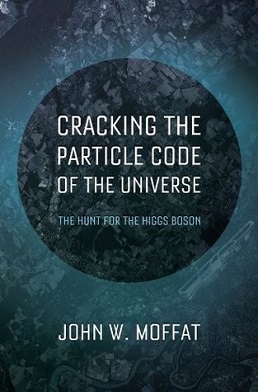
Cracking the Particle Code of the Universe: The Hunt for the Higgs Boson is a 2014 popular science book by Canadian physicist John Moffat. The first half of the book gives the reader an explanation of the particle physicists' Standard Model and the physical concepts associated with it, together with some possible alternatives to, and extensions of, the Standard Model. In the second half of the book, Moffat gives his personal account of how the discovery of the Higgs boson actually happened at the Large Hadron Collider (LHC). He writes about conferences he attended and interviews with some of the LHC physicists.
